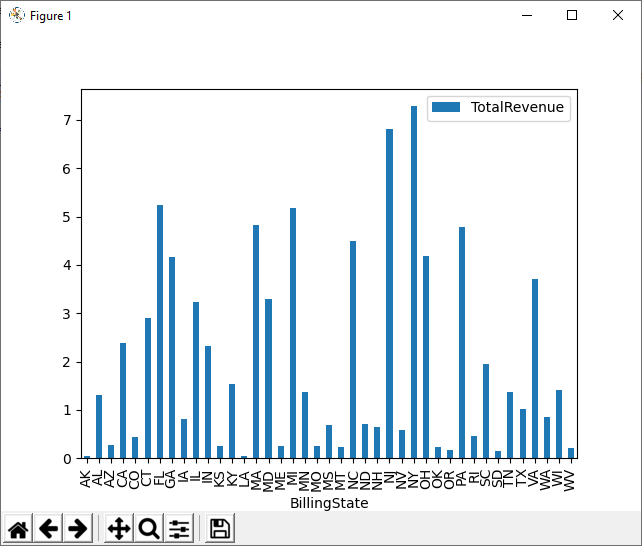Discover how a bimodal integration strategy can address the major data management challenges facing your organization today.
Get the Report →How to Visualize Bitbucket Data in Python with pandas
Use pandas and other modules to analyze and visualize live Bitbucket data in Python.
The rich ecosystem of Python modules lets you get to work quickly and integrate your systems more effectively. With the CData Python Connector for Bitbucket, the pandas & Matplotlib modules, and the SQLAlchemy toolkit, you can build Bitbucket-connected Python applications and scripts for visualizing Bitbucket data. This article shows how to use the pandas, SQLAlchemy, and Matplotlib built-in functions to connect to Bitbucket data, execute queries, and visualize the results.
With built-in optimized data processing, the CData Python Connector offers unmatched performance for interacting with live Bitbucket data in Python. When you issue complex SQL queries from Bitbucket, the driver pushes supported SQL operations, like filters and aggregations, directly to Bitbucket and utilizes the embedded SQL engine to process unsupported operations client-side (often SQL functions and JOIN operations).
Connecting to Bitbucket Data
Connecting to Bitbucket data looks just like connecting to any relational data source. Create a connection string using the required connection properties. For this article, you will pass the connection string as a parameter to the create_engine function.
For most queries, you must set the Workspace. The only exception to this is the Workspaces table, which does not require this property to be set, as querying it provides a list of workspace slugs that can be used to set Workspace. To query this table, you must set Schema to 'Information' and execute the query SELECT * FROM Workspaces>.
Setting Schema to 'Information' displays general information. To connect to Bitbucket, set these parameters:
- Schema: To show general information about a workspace, such as its users, repositories, and projects, set this to Information. Otherwise, set this to the schema of the repository or project you are querying. To get a full set of available schemas, query the sys_schemas table.
- Workspace: Required if you are not querying the Workspaces table. This property is not required for querying the Workspaces table, as that query only returns a list of workspace slugs that can be used to set Workspace.
Authenticating to Bitbucket
Bitbucket supports OAuth authentication only. To enable this authentication from all OAuth flows, you must create a custom OAuth application, and set AuthScheme to OAuth.
Be sure to review the Help documentation for the required connection properties for you specific authentication needs (desktop applications, web applications, and headless machines).
Creating a custom OAuth application
From your Bitbucket account:
- Go to Settings (the gear icon) and select Workspace Settings.
- In the Apps and Features section, select OAuth Consumers.
- Click Add Consumer.
- Enter a name and description for your custom application.
- Set the callback URL:
- For desktop applications and headless machines, use http://localhost:33333 or another port number of your choice. The URI you set here becomes the CallbackURL property.
- For web applications, set the callback URL to a trusted redirect URL. This URL is the web location the user returns to with the token that verifies that your application has been granted access.
- If you plan to use client credentials to authenticate, you must select This is a private consumer. In the driver, you must set AuthScheme to client.
- Select which permissions to give your OAuth application. These determine what data you can read and write with it.
- To save the new custom application, click Save.
- After the application has been saved, you can select it to view its settings. The application's Key and Secret are displayed. Record these for future use. You will use the Key to set the OAuthClientId and the Secret to set the OAuthClientSecret.
Follow the procedure below to install the required modules and start accessing Bitbucket through Python objects.
Install Required Modules
Use the pip utility to install the pandas & Matplotlib modules and the SQLAlchemy toolkit:
pip install pandas pip install matplotlib pip install sqlalchemy
Be sure to import the module with the following:
import pandas import matplotlib.pyplot as plt from sqlalchemy import create_engine
Visualize Bitbucket Data in Python
You can now connect with a connection string. Use the create_engine function to create an Engine for working with Bitbucket data.
engine = create_engine("bitbucket:///?Workspace=myworkspaceslug&Schema=InformationInitiateOAuth=GETANDREFRESH&OAuthSettingsLocation=/PATH/TO/OAuthSettings.txt")
Execute SQL to Bitbucket
Use the read_sql function from pandas to execute any SQL statement and store the resultset in a DataFrame.
df = pandas.read_sql("SELECT Title, ContentRaw FROM Issues WHERE Id = '1'", engine)
Visualize Bitbucket Data
With the query results stored in a DataFrame, use the plot function to build a chart to display the Bitbucket data. The show method displays the chart in a new window.
df.plot(kind="bar", x="Title", y="ContentRaw") plt.show()

Free Trial & More Information
Download a free, 30-day trial of the CData Python Connector for Bitbucket to start building Python apps and scripts with connectivity to Bitbucket data. Reach out to our Support Team if you have any questions.
Full Source Code
import pandas
import matplotlib.pyplot as plt
from sqlalchemy import create_engin
engine = create_engine("bitbucket:///?Workspace=myworkspaceslug&Schema=InformationInitiateOAuth=GETANDREFRESH&OAuthSettingsLocation=/PATH/TO/OAuthSettings.txt")
df = pandas.read_sql("SELECT Title, ContentRaw FROM Issues WHERE Id = '1'", engine)
df.plot(kind="bar", x="Title", y="ContentRaw")
plt.show()





